LACE MONITOR
Class: Reptilia Genus: Varanus
Order: Squamata Speicies: varius
Family: Varanidae Common Name: Lace Monitor/Goanna
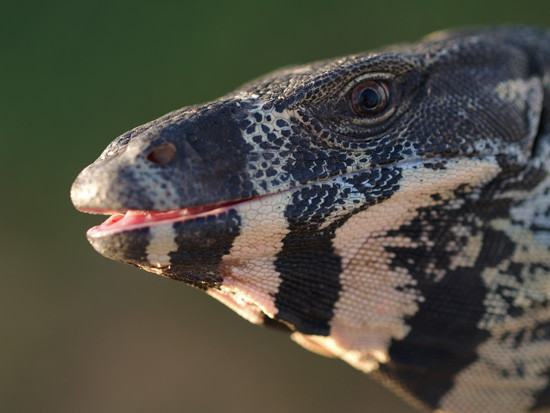
Range
These common terrestrial and often arboreal monitors are found in eastern Australia and range from Cape Bedford on Cape York Peninsula to south-eastern South Australia. They frequent both open and closed forests. They are often found in River Redgums and other large trees, but are also found in mallee habitats with smaller trees and forage over long distances (up to 3 km a day). They are often found scavenging around picnic areas and camping grounds and have been known to enter houses built in bushland. Lace Monitors rely heavily on their strong claws and agility. When threatened they head for the nearest tree and climb to safety. They are mainly active from September to May, but are inactive in cooler weather and shelter in tree hollows or under fallen trees or large rocks.
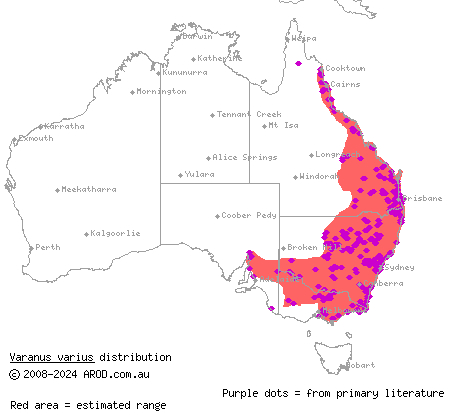
Size
Lace monitors are the second-largest monitor in Australia after the Perentie. They can be as long as 2.1 m (over 6.8 ft) with a head-and-body length of up to 76.5 cm (2.5 ft). The maximum weight of lace monitor can be over 15 kg, but most adults are much smaller.
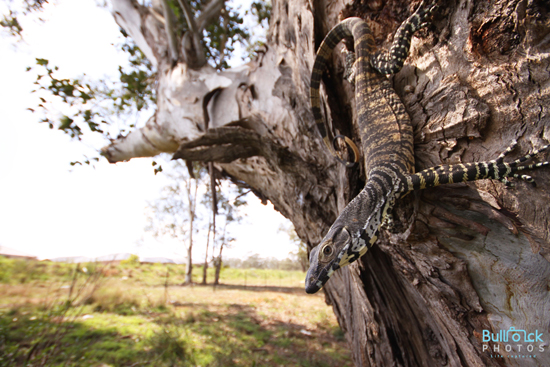
Forms
They occur in two distinct colour forms, with some variation in pattern and colour within the forms. The predominant being dark grey to black with a fine pattern of cream to yellow bands or spots. Southern animals tend to be more banded and northern more spotted. Snouts are strongly marked with prominent black and yellow bands extending under the chin. A second colour form known as Bell’s phase occurs in some dry areas of Queensland and New South Wales which has strong dark grey and yellow bands all along the body. Juveniles are far more brightly and cleanly patterned.
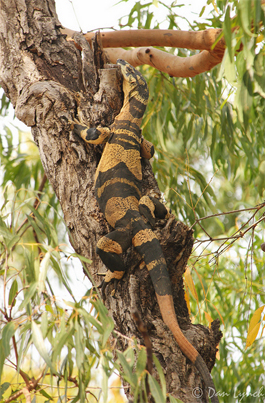
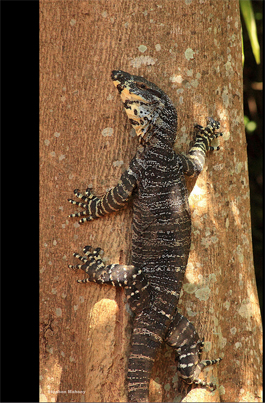
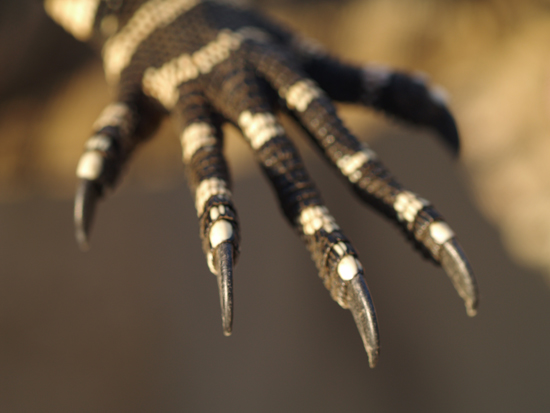
Breeding
Lace Monitors reach sexual maturity at about 4 to 5 years of age. The breeding season extends from about September to December. Several males may approach a receptive female, and engage in ritual combat to establish dominance.
Rival males will rise up on their hind legs and hold each other up with their front legs, while inflating their throat pouch to intimidate each other. Eventually one male will sprawl to the ground in defeat, or retreat into the shelter of a hollow log.
The females lay 4 to 14 eggs in spring or summer in termite nests. The female excavates a hole on the side of the termite mound, lays the eggs and then leaves the termites to reseal the eggs inside the next. It is believed that the mother is aware of when the eggs are due to hatch (between 8 and 9 months later) and she will return to the next to open it up with her strong claws to allow the baby monitors to escape.
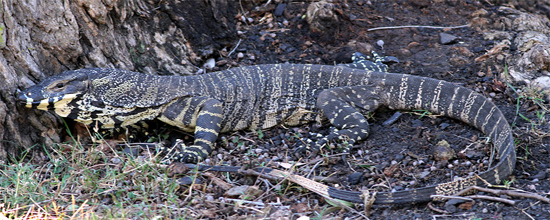
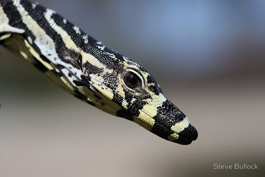
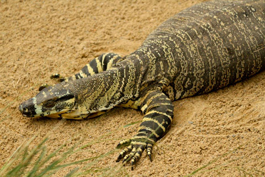
Diet
Their diets typically consist of insects, reptiles, small mammals, birds, and birds' eggs. They are also carrion eaters, feeding on already dead carcasses of other wildlife. Lace monitors will also forage in areas inhabited by people, raiding chicken coops for poultry and eggs, rummaging through unprotected domestic garbage bags, and trash cans in picnic and recreational areas.
Its strong jaws contain very long, sharp teeth that can inflict serious injury. Recent work by Brian Fry at the University of Melbourne shows that monitors actually produce mild venom similar to rattlesnake venom. While this toxin has only a slight effect on people, it is may help subdue small prey animals.
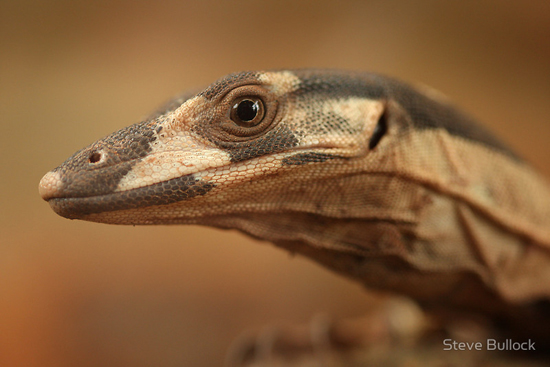
Captivity
Housing
Lace monitors are best housed in spacious outdoor enclosures due to their size and tolerance of conditions. They may be housed indoors if sufficient enclosure size is available to encourage exercise. Branches and rock piles should be provided to encourage climbing and a variety of hides should be offered as well as dry areas. If kept indoors, supplementary heating should be provided with temperatures reaching 45-60 degrees C. Ultraviolet light should also be provided when housing indoors. Minimum cage sizes are now required by law – See NPWS.
Sexing
As adults it is much easier to sex most monitor species with males being larger in size and having a broader more robust head. Comparing head shots from side on perspectives often gives a good indication of sex with males having a more pronounced snout. Males can also be 20-30% larger than females and often have a stronger feeding response. Adult males also display obvious hemipenal bulges which are far more difficult to see in juveniles. X-Rays can also be used to determine the presence of hemipenal ossifications in mature males.

Breeding
Sexual maturity is reached typically around 2-3 years in captivity. The breeding cycle is triggered by the increase in temperatures and food availability, associated with spring in southern Australia. Once females have entered into the receptive phase of the breeding cycle the males will pursue them relentlessly with constant tongue flicking and jerky movements and they will copulate regularly over a week or two.
Egg laying occurs between 22-36 days after mating. Ovulation can be identified with the female appearing bloated and uncomfortable; they may also adopt a ‘hanging position’ from cage furniture, apparently to relieve pressure of the ova on her internal organs. After ovulation, the females’ appetite is significantly reduced until food is refused entirely as egg-laying approaches. Egg-laying is usually in soil and mulch in captivity, with a deep moist and warm substrate necessary. Males should be removed before egg-laying.
Lace monitor eggs have a long incubation period, typical of larger monitors. Perlite is an ideal substrate for incubation and should be mixed with a roughly equivalent weight of water. A good average temperature is 29.5 degrees C and an average of 260 days is the incubation period.
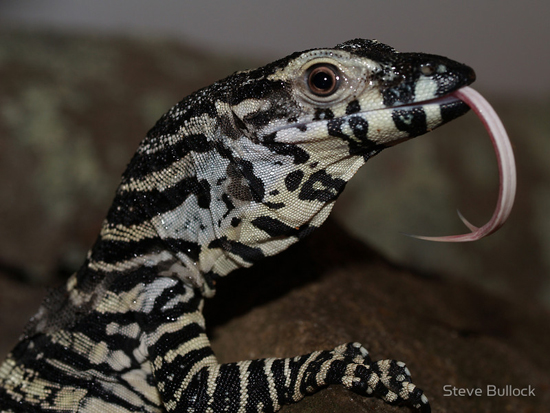
Hatchlings
Hatchlings are often very shy and defensive of intrusion. Hatchlings should be left alone, not handled until they become more comfortable with keeper movements. Gradually they will become less defensive however if continually harassed will spend most of the time hidden. They should be provided with a variety of hiding places and a suitable substrate that provides some humidity to aid shedding and place to burrow. Food should be left out for the monitor to eat in its own time, a diet of chopped mice or chicken will stimulate the appetite.
The average life span is between 10-15 years however captive specimens have been known to live up to 40 years.
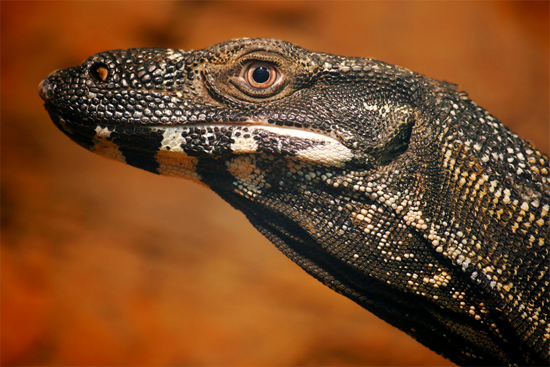
References
Brown, Danny Dr (2012). A Guide to Australian Monitors in Captivity, Reptile Publications.
Ehmann, Harald. (1992). Encyclopedia of Australian Animals: Reptiles. The Australian Museum.
Griffiths, Ken (2006). Frogs & Reptiles of the Sydney region, Reed New Holland Australia
Horn, H.G. (1991). Breeding of the Lace Monitor (Varanus varius) for the 1st time outside of Australia (Reptilia: Sauria: Varanidae). Mertensiells, Vol 2: 168-175.
Kirshner, D. (2007) Multiclutching in captive Lace Monitors, Varanus varius. Mertensiella (16): 403-421
Smith, D (2003). Lace & Bells Monitors, Reptiles Australia, Vol 1: Issue 2
Swan, Mike (2008). Keeping & Breeding Australian Lizards, Mike Swan Herp. Books
Wilson, Steven & Swan Gerry (2013). A Complete Guide to Reptiles of Australia. 4th Edition. Reed New Holland Australia

